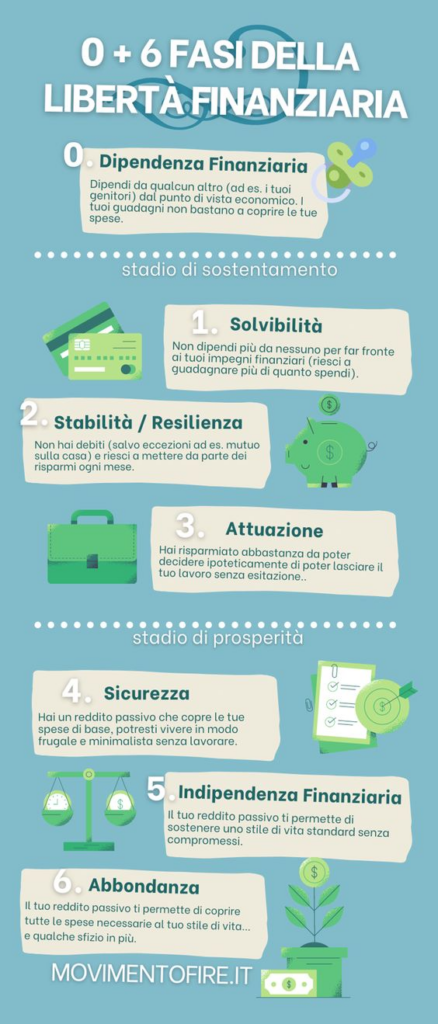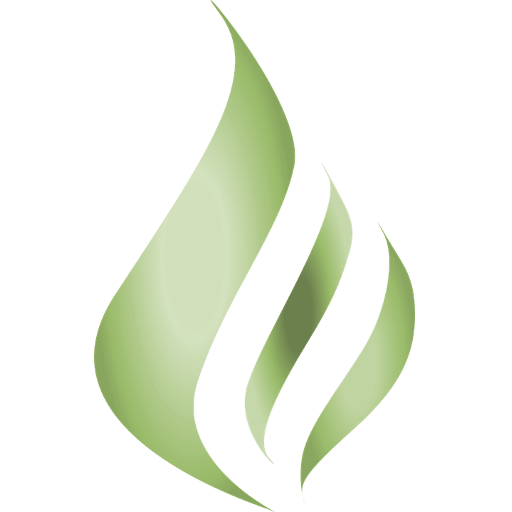The Financial freedom is the status of those who do not need to work to live, because their own sources of passive income allow you to earn income above your usual expenses.
There is no traditional path to financial independence, but there are certain stages that each of us goes through in life from a personal finance perspective.
On the English forums I saw talk about "Six Stages of Financial Freedom” (“six stages of financial freedom“).
This is one way of looking at the path to financial independence six phases (seven actually, if we consider the initial stage in which we are not independent) – from the total lack of economic freedom to the abundance that allows you to live on income.
Who follows the FIRE movement aspires to reach those stages where one is no longer dependent on other people for one's livelihood, and you can maintain the lifestyle you want for yourself and your family.

The Six Stages of Financial Freedom
Phase 0 – Financial Dependence
At this stage you receive financial support from other people. Everyone starts here: your lifestyle depends on the financial support you receive (most of the time from your family). The time it takes to free varies from person to person.
Those who no longer rely on their parents for their livelihood and do not accumulate too much debt are eventually able to leave this phase.
The phase 0 it is the lack of financial independence. To begin the path to financial freedom you need to start earning a profit (= more than you spend), passing through first three phases of “sustenance”:
Phase 1 – Solvency
Solvency is the ability to meet your financial obligations. You reach this stage when you no longer depend on anyone for financial support.
This means that your income is greater than your expenses (you are earning a profit) and you are no longer accumulating debt (except for “good” debts like a home loan, as long as you can cover the installments with your income).
Some manage to reach this stage at a very young age, other not. In Italy, young people tend to find work later and receive financial support from their parents for longer, but at the same time they tend to have less debt (ad is. university) compared to young people abroad.
Phase 2 – Stability / Resilience
Stability is achieved after paying off all debt, set aside an emergency fund, and you continue to earn a personal profit. It's possible you still have some “good” debt (education or mortgage), but you paid for everything else. You are also able to deal with any emergencies and unexpected expenses.
In the USA It is recommended to set aside at least six times your monthly salary in an emergency package, but in Europe social benefits and the healthcare system cover most of the expenses and in this case an emergency package covering three months' salary may be sufficient (ask yourself too: if I were to lose my job at any moment, how long would it take me to replace him??).
Phase 3 – Implementation
At this stage of financial independence, you have the ability to live and work the way you want. You have eliminated all debts, including any student loans and mortgages. Or you would have the option to do so (that is, you could buy a house with cash, but you still decide to open a mortgage).
You have saved enough that you could quit your job at a moment's notice without hesitation if you wanted to do so.
Pass the first three sustenance phases, in the last three stages concerns shift from surviving to thriving. Money is no longer a safety net. Now it's a tool to help you build the life you want for you and your family.
Understanding what gives meaning and purpose to your life is an essential part of financial freedom and a cornerstone of the FIRE movement.
Phase 4 - Safety
You reach the safety stage when your passive income it can cover your basic needs. In other words, based on how much you have saved and invested, you could technically retire and live a frugal, minimalist life, below average.
Even if I didn't work anymore, you could afford simple accommodation, basic food, essential clothing and necessary medical care.
For followers of “Lean” FIRE this could already prove to be the final goal, but most people aspire to a less prohibitive lifestyle.
Phase 5 – Financial Independence
This is thefinancial independence by definition, the “FI” of the “FI/RE”: your passive income can support your current standard of living.
Second the rule of 4%, the money you saved and invested would allow you to live as you do today… until the day you die. For most people, this is the ultimate goal: not having to work to live.
The amount needed to reach this stage depends from person to person, based on various factors: Where do you live, you have other dependents, you have medical expenses, what is your lifestyle.
Some people can live peacefully on €1,500 a month (nd. the average salary in Italy), other not.
One of the main steps towards FIRE is being able to determine what it is your personal FIRE target, that allows you to live the lifestyle you prefer.
Phase 6 – Abundance
In the final stage of financial freedom, you have “enough – and a little more”. Your passive income from all sources not only does it have the ability to fund your lifestyle indefinitely, ma It also gives you the freedom to do whatever you want: indulge yourself in luxury, build a business empire, establish a charitable foundation, explore the world, build a space program to rival NASA.
The more money you save, the more freedom you have, the more risks you can take. As your financial independence increases, you will have fewer worries, and you will be able to make decisions proactively rather than reactively.
The fundamental principle of FIRE consists in live below your limits, and you have reached the stage where you can raise the limit without compromising your lifestyle.

Financial Freedom in Brief
- The financial freedom (o financial independence) it is an economic situation in which you do not need to work to live. It can be achieved through various stages:
- 0. Lack of financial autonomy: you depend on others to live;
- 1. Solvency: what you earn exceeds your expenses, allowing you to save;
- 2. Resilience: you have an emergency fund that would allow you to live for a limited period of time without working;
- 3. Implementation: you have enough savings that you can technically quit your job at any moment;
- 4. Safety: you have sources of passive income that would allow you to cover basic household expenses, food and health, living below your means;
- 5. Financial Independence: you have passive income that would allow you to maintain your average lifestyle without working;
- 6. Abundance: you have passive income that would allow you to live comfortably on your income, allowing you some luxuries.

The Italian community of the FIRE movement (Financial Independence, Retire Early) to stop working and retire young.